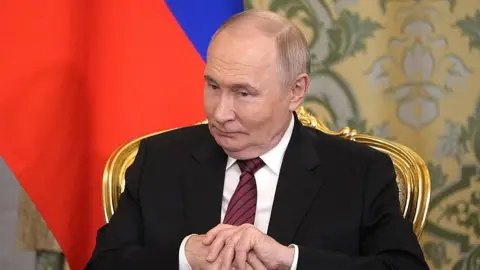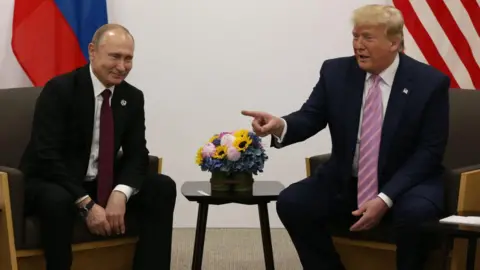Hectic two weeks leaves Russia confident – and peace in Ukraine feeling no closer
15 minutes agoSteve RosenbergRussia editor

 PAVEL BEDNYAKOV/POOL/AFP via Getty
PAVEL BEDNYAKOV/POOL/AFP via GettyIt’s 2:30am.
Inside the Kremlin walls I’m wandering alone through the vast grounds trying – and failing – to find my way out.
I spot a checkpoint, approach and show my passport.
“Nyet vykhoda!” [“No exit!”] replies the guard. He points in the opposite direction.
I walk back and, eventually, come to another checkpoint.
“No way out!” says the sentry.
I’m lost. Inside the Kremlin. In the dead of night.
It’s like being in a John le Carré novel.
It’s been quite an evening. I arrived at 5pm. Along with a small group of journalists, I’d been invited to “an event with President Putin”. What kind of event? To begin with the Kremlin wouldn’t say. Eventually we were told Vladimir Putin would be taking questions.
Eight hours later, the president strode into the Malachite Hall of the Grand Kremlin Palace and sat at a desk.
But there’d been a change of plan. No press conference. No questions. Instead, live on Russian TV, Putin delivered a statement in which he proposed direct talks between Russia and Ukraine in Istanbul.
Event over, I walk out of the Kremlin Palace but take a wrong turn. Finally, I locate the correct exit and, bleary-eyed, take a taxi home.
This was the start of what has turned out to be a real rollercoaster of a fortnight. What began with a late-night Kremlin statement continued with peace talks in Turkey and then a two-hour telephone call between Putin and Donald Trump.
But, at the end of it, are we any closer to peace in Ukraine?
It doesn’t feel like it.

 Mikhail Svetlov/Getty Images
Mikhail Svetlov/Getty ImagesAlthough there is talk about more talks, and of а possible future “memorandum” on a “possible future peace”, it all sounds rather vague.
For now, the fighting goes on.
Russia is still refusing to sign up to an unconditional comprehensive ceasefire. It has no intention of returning any of the Ukrainian land it has seized, occupied and claims to have annexed. On the contrary: it’s pushing for more.
Right now, the Ukraine peace process resembles being lost in the Kremlin late at night.
It’s hard to see the exit.
The Kremlin side-step
And yet the past two weeks have revealed a lot.
First, how Russia neutralises potential threats and pressure points.
Kremlin critics would put this another way: how Russia plays for time.
On 10 May (a few hours before I got lost in the Kremlin), after a phone call with Donald Trump, European leaders had issued an ultimatum to President Putin: agree to an unconditional long-term ceasefire in Ukraine in two days or face crushing new sanctions.
Since March the Trump administration has been calling on Russia and Ukraine to accept a 30-day comprehensive ceasefire. Kyiv agreed. Moscow hasn’t.
The Kremlin leader sidestepped the European ultimatum with his counter proposal of direct talks in Turkey. The idea was greeted with scepticism in Ukraine and across Europe. But it was enough to placate Trump and convince him Russia was serious about wanting peace. He was all for the talks. “Crushing” new sanctions were delayed.
Ahead of the Istanbul meeting on 16 May, President Trump gave the impression that Vladimir Putin might attend. The Kremlin leader did not, sending instead a comparatively low-level delegation that once more rejected the idea of a long-term ceasefire. But, again, the modest results of the talks were sufficient to persuade the US president that progress was being made.
Then came the Trump-Putin phone call on 19 May.
By the end of it, Russia had still not agreed to an immediate comprehensive cessation of hostilities. Instead, according to President Trump, “Russia and Ukraine will immediately start negotiations toward a ceasefire and, more importantly, an END to the War”.
But Moscow is already casting doubt on whether it would sign any future peace treaty with Ukrainian President Volodymyr Zelensky. For a year now the Russian authorities have been attempting to delegitimise Ukraine’s president since the expiry of his presidential term. However, Ukraine’s Constitution prohibits the holding of elections in wartime.
And the reason for martial law in Ukraine is Russia’s invasion.
“Would Russia sit down and sign a peace agreement with President Zelensky?” I asked Russia’s foreign minister Sergei Lavrov on Friday.
“You’re putting the cart before the horse,” Mr Lavrov replied. “First we need to have a deal. When it’s agreed, then we will decide. But, as President Putin has said many times, President Zelensky does not have legitimacy… Probably the best option would be new elections…”
Confident Russia
The Russian media has concluded that, after two weeks of diplomacy, Moscow has strengthened its hand.
“Russia has won the latest round of global poker,” declared the Izvestia newspaper last week.
“Donald Trump’s stance couldn’t be more advantageous to Moscow,” wrote Kommersant. “In effect he backed Russia’s position of ‘Talks first, ceasefire later’ and refused to strengthen sanctions against Russia.”
A social scientist told Kommersant: “Donald Trump, at least for now, is our ideological partner on certain issues. His views are much closer to Russia’s than to Europe’s.”
And the ultra pro-Kremlin Komsomolskaya Pravda had this message for European leaders:
“You were warned. Don’t wave threats and ultimatums in the face of the bear. Don’t try to impose conditions in talks that have nothing to do with you.
“Just sit in the lobby and breathe in the smell of the new world order.”
Moscow’s confidence is also fuelled by the belief that, in Ukraine, it holds the initiative on the battlefield.
Reluctant Trump
Back in 2023 Donald Trump had promised that, if he won the presidency, “we will have the horrible war between Russia and Ukraine settled… I’ll get them both. I know Zelensky, I know Putin. It’ll be done within 24 hours, you watch”.
Trump has been in the Oval Office for more than four months now, but the “horrible war” goes on.
On rare occasions, he has publicly rebuked the Kremlin and threatened further sanctions. Last month he said: “…there was no reason for Putin to be shooting missiles into civilian areas, cities and towns, over the last few days. It makes me think that maybe he doesn’t want to stop the war, he’s just tapping me along, and has to be dealt with differently, through ‘Banking’ or ‘Secondary Sanctions?'”
But there’s been no follow-through. The US president appears reluctant to ratchet up the pressure on the Kremlin, instead signalling to Moscow that he’s keen to reboot US-Russia relations.

 Office of the President of Ukraine via Getty Images
Office of the President of Ukraine via Getty ImagesFollowing the presidents’ telephone conversation, Putin’s foreign policy advisor Yuri Ushakov, who’d sat in on the call, told journalists: “Trump spoke rather emotionally about the prospects for [bilateral] relations. Trump sees Russia as one of America’s most important partners in trade and economic matters.”
President Trump seems determined to push on with his rapprochement with Russia, whatever happens on Ukraine.
And Moscow senses that.
“President Trump does not link continued US-Russia dialogue to the Ukraine peace process,” was a headline in the Russian government paper Rossiyskaya Gazeta this week.
That doesn’t mean the Kremlin has headed off the danger of additional restrictions completely. The US Senate has threatened tough new sanctions against Russia if Moscow doesn’t get serious about diplomacy.
Up to this point the Kremlin has been able to deflect or to sidestep whatever pressure it’s come under to make compromises and concessions regarding its war on Ukraine.
It seems confident it will continue to do so.